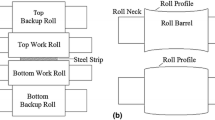Abstract
Due to the special working conditions, work rolls are severely worn during hot temper rolling process, which adversely affects the shape accuracy of the strip. However, most of the existing literature about roll wear concern more about hot rolling than hot temper rolling. In this study, the wear mechanism of the work rolls is analyzed based on numerous measured wear contours and wear characteristic of the work rolls. To reveal the wear evolution laws, a high-precision elastic–plastic finite element method (FEM) analysis of tempering rolling is built using the FEM software ABAQUS. Simulation results show the distribution laws of contact pressure are very consistent with the wear evolution laws. Field application proves that the actual wear of the work rolls shows good agreement with the obtained wear evolution laws, indicating that the wear evolution laws are accurate and reliable. This research has the important theory and application value for the analysis of the influencing factors of roll wear and the improvement in non-uniform wear.












Similar content being viewed by others
References
H. Kijima, Influence of roll radius on contact condition and material deformation in skin-pass rolling of steel strip. J. Mater. Process. Technol. 213(10), 1764–1771 (2013)
S. John, S. Sikdar, A. Mukhopadhyay, A. Pandit, Roll wear prediction model for finishing stands of hot strip mill. Ironmak. Steelmak. 33(2), 169–175 (2006)
M. Tahir, B. Widell, Roll wear evaluation of HSS, HiCr and IC work rolls in hot strip mill. Steel Res. Int. 74(10), 624–630 (2003)
R. Colása, J. Ramírezb, I. Sandovalb, J.C. Morablsb, L.A. Leducb, Damage in hot rolling work rolls. Wear. 230(1), 56–60 (1999)
O. Kato, H. Yamamoto, M. Ataka, K. Nakajima, Mechanisms of surface deterioration of roll for hot strip rolling. ISIJ Int. 32(11), 1216–1220 (1992)
Q. Dong, J.G. Cao, D. Wen, Spalling prevention and wear improvement of rolls in steel strip hot-rolling process. J. Fail. Anal. Prev. 15(5), 626–632 (2015)
C.S. Li, X.M. Zhang, X.H. Liu, G.D. Wang, Experimental investigation of mathematic model on rolls wear in rolling. Chin. J. Mech. Eng. 38(7), 28–30 (2002)
J. Zhang, H.B. Xu, H.B. Li, H.C. Liu, Y.Z. Zhou, Uneven wear of work roll and its reduction measurement on hot strip temper mill. J. Cent. South Univ. (Sci. Technol.) 42(6), 1611–1616 (2011)
H.B. Xu, J. Zhang, J.G. Cao, H.C. Liu, Y.Z. Zhou, A.S. Wang, X.Y. Zhu, J. Li, Optimization and application of roll contour configuration of long shifting stroke hot tempering mill. J. Cent. South Univ. (Sci. Technol.) 41(4), 1340–1347 (2010)
Q.D. Zhang, L.W. Huang, B. Wu, J.X. Song, G.X. Zhang, Experimental research on the surface scale of hot rolled steel strip. Shanghai Met. 22(5), 32–34 (2000)
Z.M. Wu, Formation causes of scale of hot-rolled strip and its countermeasures. Steel Roll. 24(3), 56–58 (2007)
Y.J. Wang, H.J. Dong, H.L. Mu, J.G. Chen, Analysis on scale microstructure of coiled hot rolled strip. China Metall. 17(10), 40–44 (2007)
M. Torres, R. Colás, A model for heat conduction through the oxide layer of steel during hot rolling. J. Mater. Process. Technol. 105(3), 258–263 (2000)
L.F. Cai, J. Zhang, J.G. Cao, G.C. Wei, G. Chen, X.Y. Zhu, Study on the wear of the working roll in temper rolling mill for hot strip. Metall. Equip. 4, 38–41 (2007)
X.Y. Li, J. Zhang, X.L. Chen, X.M. Zhao, S.H. Jia, T. Huang, Wear of rolls in single-stand temper mill and its effect on strip shape. J. Univ. Sci. Technol. Beijing 24(3), 326–328 (2002)
G.H. Yang, J. Zhang, Y.Z. Zhou, A.S. Wang, X.Y. Zhu, Work roll non-uniform wear and shape control performance of the 2250 hot temper mill in WISCO. J. Univ. Sci. Technol. Beijing 31(8), 1051–1056 (2009)
L.S. Chen, J.C. Lian, Study on roll wear on hot strip rolling mill. Iron Steel 36(1), 66–69 (2001)
B. Li, Study on the plastic deformation and flatness generation of ultra-high strength steel strip during temper rolling. Ph.D. Thesis, University of Science and Technology Beijing, 2014
B. Li, Q.D. Zhang, X.F. Zhang, Two-dimensional numerical simulation of residual stress of strip in temper rolling process. Steel Roll. 31(1), 14–18 (2014)
Acknowledgments
This research is supported by the Beijing Natural Science Foundation (Grant No. 3182026), the National Natural Science Foundation of China (Grant No. 51604024), the Tribology Science Fund of State Key Laboratory of Tribology (Grant No. SKLTKF16B11), and the Fundamental Research Funds for the Central Universities (Grant No. FRF-TP-17-002A2).
Author information
Authors and Affiliations
Corresponding author
Rights and permissions
About this article
Cite this article
Song, G., Yang, Q. & Wang, X. Research on Wear Evolution Laws of the Work Rolls during Hot Temper Rolling Process. J Fail. Anal. and Preven. 18, 912–919 (2018). https://doi.org/10.1007/s11668-018-0480-y
Received:
Revised:
Published:
Issue Date:
DOI: https://doi.org/10.1007/s11668-018-0480-y




